A little over a month after the sudden death of President Ebrahim Raisi in a helicopter crash, Iranians will vote for their next president this Friday. With six candidates on the ballot and no clear favorite, the outcome is far from certain — a clear change, analysts say, from the last election.
World
Iran is picking a new president. Here’s what to know.

“Ebrahim Raisi was elected in an entirely uncompetitive election in 2021 when the results were preordained,” said Arash Azizi, a writer and historian who focuses on Iran. “The results are not preordained this time.”
Iran’s political system means the president has limited power. The Islamic republic’s supreme leader — Ayatollah Ali Khamenei — maintains direct or indirect control of all branches of government, as well as of the military and the media. However, the next president could have a significant impact on daily life, including religious requirements and dress restrictions — consequential in a country recently rocked by protests demanding freedom for women in the theocracy.
Votes could be tallied as soon as Sunday. But experts think it likely that none of the six contenders will win a simple majority, in which case Iranians will take to the polls once more in July for a runoff election between the two front-runners.
Individuals seeking election to Iran’s presidency or parliament must receive approval from the Guardian Council, which vets candidates to ensure they adhere to the principles of the Islamic republic. In practice, all 12 members of the council — six clerics and six jurists — are directly or indirectly appointed by Khamenei.
Eighty candidates entered the race to be president. The council approved six, all of whom are men. One or more contenders could drop out in the final stretch, Iran watchers told The Washington Post, and throw their weight behind a unity candidate as in past elections.
Ghalibaf, 62, has served as speaker of parliament since 2020 and was mayor of Tehran from 2005 to 2017. He boasts an extensive military history — including three years as commander of the Islamic Revolutionary Guard Corps’ air force — and maintains close ties to the IRGC, a powerful political force within the Islamic republic. A conservative, Ghalibaf is known for his role in harsh crackdowns on student protesters in Iran while serving as an IRGC general and later as police chief.
GET CAUGHT UP
Stories to keep you informed
Though he served as the country’s nuclear negotiator, Jalili is a critic of international negotiations over Iran’s nuclear program. Jalili, 58, is a member of the Expediency Discernment Council, which was originally set up to resolve conflicts between parliament and the Guardian Council but serves in practice as an advisory body to Khamenei. If elected, Jalili is expected to continue the harsh crackdown on anti-government protesters and on Iranian women accused of violating the country’s mandatory hijab rules.
Amirhossein Ghazizadeh Hashemi
Hashemi, 53, was one of Raisi’s vice presidents and has campaigned on a continuation of the former president’s policies, including strengthening Iran’s ties with its neighbors.
Described by analysts as the sole reformist in the race, Pezeshkian is a heart surgeon who has based his campaign around Iranian women, youths and ethnic minorities. He has taken the opposite nuclear platform from Jalili, instead campaigning on the goal of reopening nuclear talks with the West. Pezeshkian, 69, served as vice president of Iran’s parliament from 2016 to 2020, strongly supported the 2015 nuclear deal, and challenged the official government narrative about the 2022 death of Mahsa Amini, a 22-year-old Kurdish Iranian woman who died in police custody after being detained for allegedly not wearing her hijab.
Pourmohammadi is the only cleric in the race. A conservative, Pourmohammadi, 64, previously served as interior minister under President Mahmoud Ahmadinejad and later as justice minister under President Hassan Rouhani. Pourmohammadi, like Raisi, held a leading role in the 1988 executions of thousands of political prisoners held in Iranian jails.
Zakani, 58, has been mayor of Tehran since 2021 and was a member of parliament from 2004 to 2016, then again from 2020 to 2021. He attempted to run for president in 2013 and 2017 but did not receive approval from the Guardian Council until 2021, when he eventually withdrew to back Raisi. Zakani’s platform includes promises of free health care for women and the elderly as well as to revitalize Iran’s currency, the rial.
The 74 disqualified candidates include government officials and lawmakers — even a former president — as well as seven women.
“Only those who accept the fundamentals of this deeply undemocratic system of the Islamic republic have ever been allowed to run,” Azizi said.
If Iranians turn out to vote, it could help the sole reformist candidate
While Pezeshkian is considered the sole reformist in the six-candidate lineup, some view him as a potential front-runner.
“It really depends on the voter turnout,” said Michelle Grisé, a senior policy researcher at Rand. “Allowing Pezeshkian to run could be viewed as an attempt to increase voter turnout, but we’ll see whether he’ll succeed in appealing to an electorate that is overwhelmingly disillusioned at this point.”
Less than half of the electorate voted in the most recent presidential election in 2021, and the March parliamentary elections saw historically low turnout, according to Grisé.
But the 2021 election was largely considered to be preordained in favor of Raisi, prompting many Iranians — especially those frustrated by the ayatollah’s conservative regime — to boycott voting altogether.
“The question is, ‘Do Iran’s moderates turn out in favor of Pezeshkian, or do they not turn out at all?’” explained Heather Williams, also a senior policy researcher at Rand, adding that the regime wants “turnout, though they would rather not get who the turnout is going to come out for.”
The election is being held early after the sudden death of the last president
Iran was slated to hold its next presidential election in 2025, but the unexpected death of Raisi moved the election up by a year. Raisi died in a helicopter crash on May 19 at age 63. According to the Islamic republic’s constitution, a special election must be held within 50 days.
Elected in 2021, Raisi was widely regarded as the victor of a rigged race, an effort by the ayatollah to uphold his conservative regime. Some analysts believed Raisi was the ayatollah’s desired successor.
In the wake of Amini’s death in 2022, mass protests calling for the theocracy’s dissolution broke out in Iran and around the world. Raisi oversaw a security crackdown during which more than 500 people were killed, according to a tally from the nongovernmental organization Iran Human Rights. Iran later announced it had pardoned more than 22,000 who had been arrested.
Raisi’s death came at a time of increasing instability and violence in the Middle East. The war in Gaza has sparked an uptick in the constantly simmering tensions between Iran and Israel, as violence rises on Lebanon’s southern border, in the Red Sea, and in Syria and Iraq, The Post reported last month. In April, Raisi oversaw the largest-ever Iranian attack against Israel in retaliation for a deadly Israeli strike on an Iranian diplomatic compound in Syria.
Most political power in Iran is held by the supreme leader
Constitutionally, the president ranks second to the supreme leader, who holds most of the power and is “the ultimate decision-making authority” on national security and defense, according to Grisé. The ayatollah has in recent years “effectively encroached” on the president’s purview, Azizi said, and seized more power.
However, as head of government, the president holds important responsibilities over elements of daily life in Iran, including overseeing the national budget and signing legislation and treaties.
Crucially, the president of the Islamic republic influences how strict its morality police are in enforcing the theocracy’s religious codes and dress restrictions, as well as the level of freedom that Iran’s media is allowed to exert.
“Then there are also some day-to-day freedoms that maybe we don’t think about as much, like who is allowed to attend sporting events or how many people are allowed to gather in public, or if women are allowed to dance publicly,” Williams said.







:max_bytes(150000):strip_icc()/roundup-writereditor-loved-deals-tout-f5de51f85de145b2b1eb99cdb7b6cb84.jpg)


